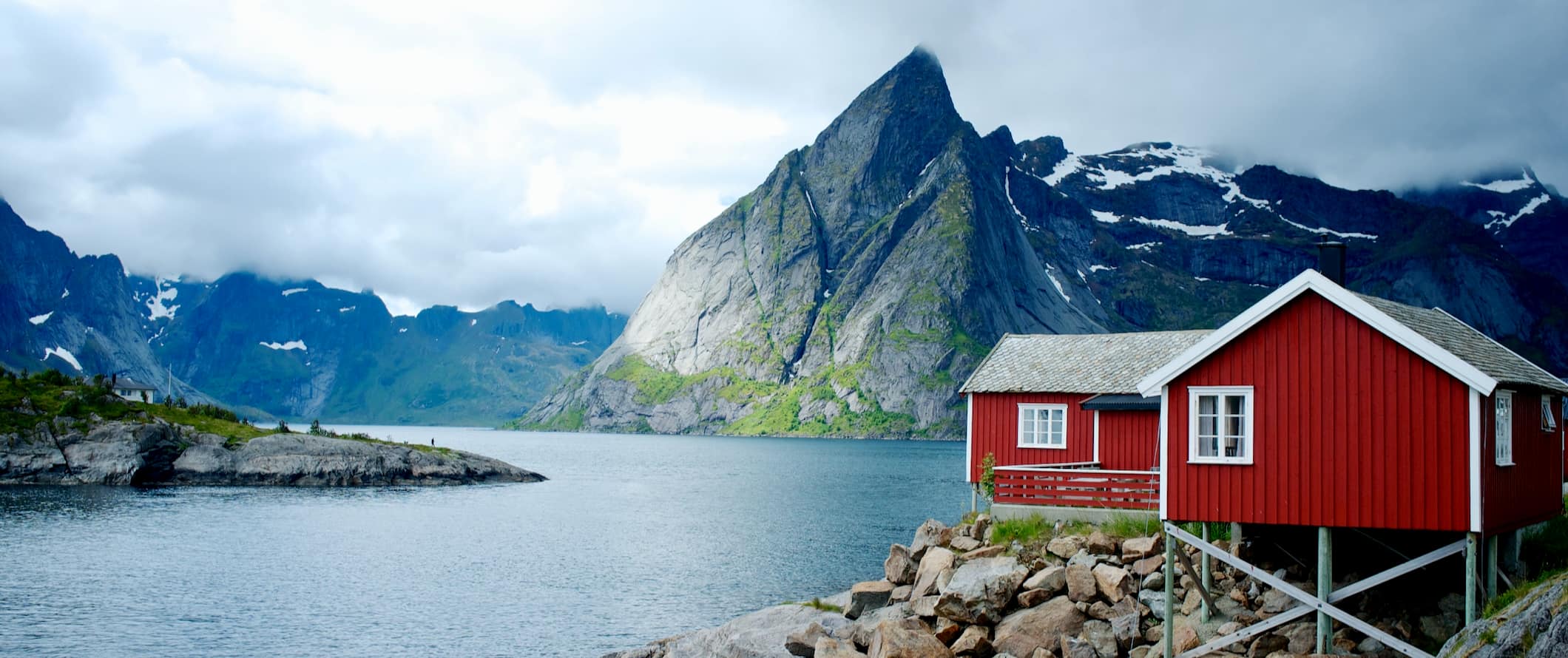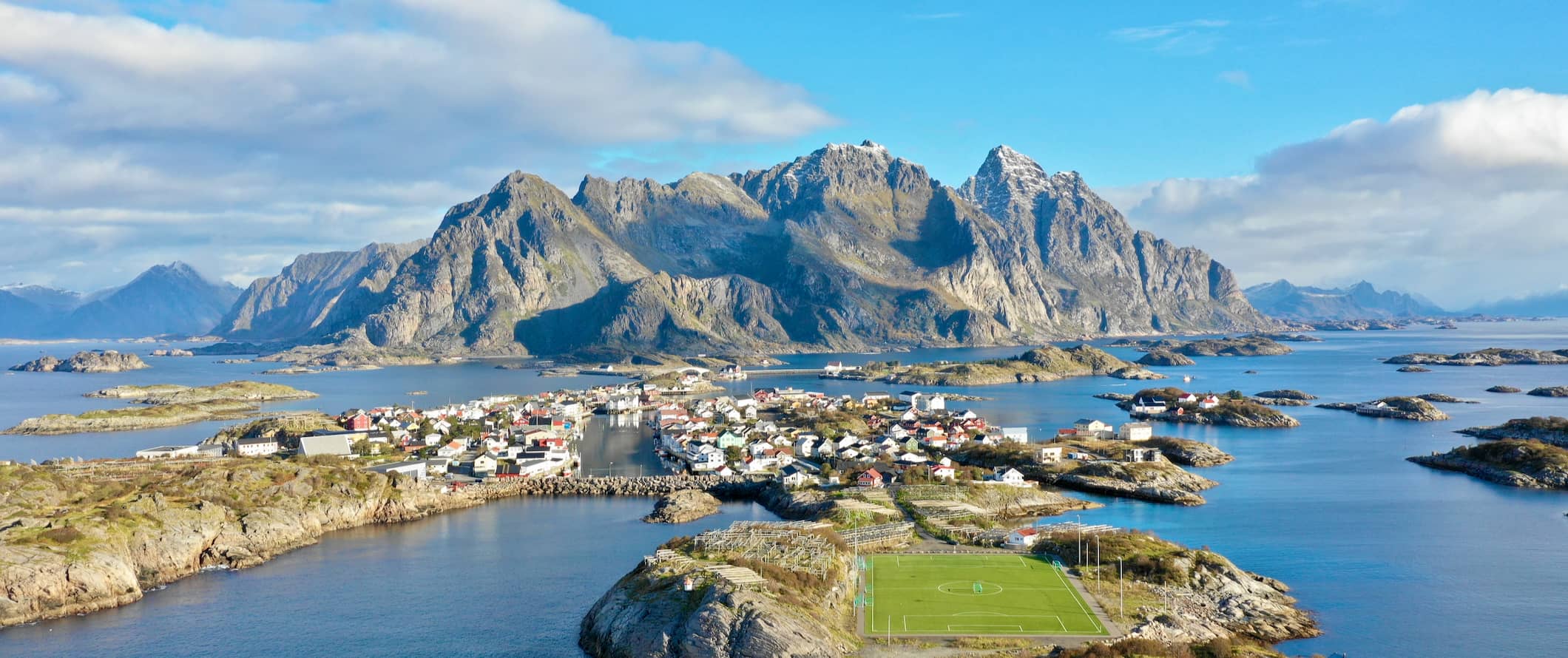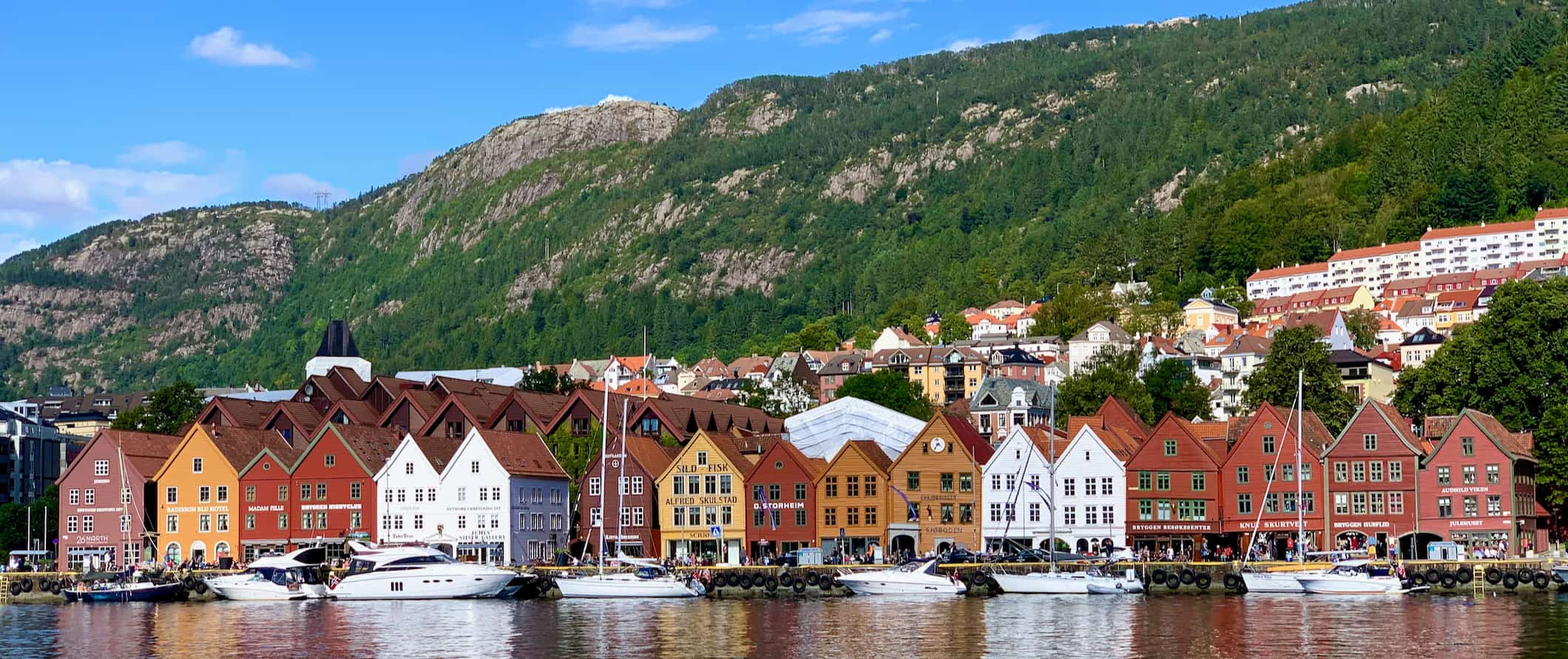 red cabin in the foreground along the rugged coastline" width="1100" height="464" />
red cabin in the foreground along the rugged coastline" width="1100" height="464" /> red cabin in the foreground along the rugged coastline" width="1100" height="464" />
red cabin in the foreground along the rugged coastline" width="1100" height="464" />
When traveling Europe, a lot of people skip visiting Norway because of how expensive it is. While it’s true that Norway is not a budget-friendly destination, it is one of the most beautiful countries in the world, rivaling iconic destinations like New Zealand and Iceland when it comes to natural beauty.
To top it all off, Norwegians are wonderful people, almost everyone speaks fluent English so it’s easy to navigate, and the scenic fjords are never far from sight.
And, since Norwegians love nature, there are a lot of free outdoor activities that can fill your days without emptying your wallet. Wild camping is also free here as well, making it the perfect destination for outdoorsy travelers.
I’ve loved all my visits to Norway. I am always blown away by the landscape, architecture, and friendly people. It’s definitely not a country to be missed, even if you are on a budget.
Use this travel guide to Norway to plan your trip, save money, and make the most of your visit to this beautiful nation!

Surrounded by high cliffs, the fjords of Norway are world renowned and breathtakingly beautiful. Geirangerfjord and Nærøyfjord near Bergen are two of the most popular. Other fjords worth seeing include Aurlandsfjord (near Flåm), Lysefjord (near Stavanger), and Trollfjord (near Tromsø). There are tons of ways to experience Norway’s natural beauty whatever your style is, from doing a fjord cruise, a kayaking tour, or going on a scenic hike to fully take in the unique landscapes.
Oslo is a beautiful small city of just under 700,000 people. Here you can browse the National Gallery, explore the Akerhus fortress, check out the Viking Ship Museum, see the Royal Palace, spend an afternoon strolling the Aker Brygge wharf, or sail around the city on a boat tour. Don’t miss Vigeland Sculpture Park either, with its 200 unique statues. The city is also surrounded by wilderness, offering plenty of places to hike, bike, swim, and camp (and, of course, cross-country ski in the winter).
Bergen is home to tons of hiking trails as well as some of the most scenic fjords in the country. Check out the fish market, stroll through the historic Gamle Bergen, climb the medieval Rosenkrantz Tower, or hike up Mount Fløyen to get a picturesque view of the city below. Just two hours outside Bergen, you can enjoy the guided walks (suitable for all levels) on the Folgefonna Glaciers and marvel at the colors of the spectacular “blue-ice” hike. Folgefonna National Park, home to the massive golden eagle, is accessible by public transportation too.
Lofoten is a picturesque scenic area in the far north well worth the effort (and cost) to get to. There are beautiful fjords to cruise, mountains, wildlife, and a slower pace of life that makes this place seem magical. Plus, there’s no shortage of activities to take advantage of, from excellent fishing and plenty of opportunities for kayaking, photo tours, sailing trips, horseback riding, and more. This is also one of several spots to see the Northern Lights mirrored in the water of this unique archipelago. It’s one of the most sought-after photography destinations in the world.
Known for its bright and colorful buildings, Trondheim is a laid-back city filled with students. Located in the middle of the country, it’s a fun destination to party and enjoy late nights out. Be sure to take a stroll through the Bakklandet neighborhood, see the Old Town Bridge, and visit the spectacular medieval Nidaros cathedral that has attracted pilgrims from Oslo for the last 400 years. The Rockheim culture center is a tribute to the history of Nordic rock music from 1950 to the present with interesting interactive exhibits and displays. If you visit in winter, don’t miss the Ice Domes (an ice hotel that you can visit on a tour or stay at overnight — for a hefty price!).
One of the best things you can do when you arrive in a new city is to take a walking tour. It’s a great way to get the lay of the land and learn about the culture, people, and history of the destination. You can find free walking tours in Oslo and Bergen — tours that give you much more insight than any guidebook. Just be sure to tip your guides at the end!
Preikestolen (Preacher’s Pulpit or Preacher’s Chair) is one of the most famous landmarks in Norway (you’ve probably seen it on Instagram). An unusually flat and wide surface located atop a cliff, the iconic Preikestolen is only reachable by hiking a 4-kilometer (2.5-mile) trail. With around 200,000 visitors per year, you’ll want to make sure you arrive early in order to take some photos without all the crowds. The hike is free and relatively easy though you’ll need to pay 250 NOK to park your car. June-September is the best time to go. Guided hikes of Preacher’s Pulpit (with transportation) start at 990 NOK.
Norway is host to some of the most spectacular natural beauty in the world. With 47 national parks (and over 3,000 protected areas), Norway offers everything from waterfalls and glaciers to reindeer, lynx, and wolves — and much more! You can also enjoy all sorts of outdoor activities, from caving and canyoning to rafting and ziplining. Consider a visit to Jostedalsbreen National Park, home to the largest glacier in continental Europe; Blåfjella-Skjækerfjella National Park, which has tons of hiking and also lots of wild reindeer; or Jotunheimen National Park, which is home to over 200 mountains you can hike and climb. The national parks are all free to enter (though there are fees for parking).
The northernmost tip of Europe, Norway’s North Cape is great for hiking, trekking, road trips, and more. Located almost 2,000 kilometers (1,242 miles) from Oslo, here you can explore the jagged coastline of Finnmark county, which includes six national parks. In the summer, the midnight sun shines for 2-3 months straight (May-July), while in the winter there are 2-3 months of complete darkness (November-January). You don’t get more remote than this!
Perfect for a 24-hour party, Tromsø in the summer is a city that doesn’t sleep because the sun is up 24/7! Located in the Arctic Circle over 1,700 kilometers (1,056 miles) north of Olso, tourists come here to experience unbroken sunlight amidst the city’s many pubs. Or, if you happen to visit in the dark and cold of winter, you can catch the vibrant northern lights. It’s also a world-famous fishing destination and home to incredible, postcard-perfect fjords. Like Lofoten, this is one of the best destinations in the country for photography.
Norway is one of the top ski destinations in the world. Rauland, Geilo, Skeikampen, and Hemsedal are all great options for snowboarding, telemark skiing (which mixes Alpine skiing and Nordic skiing), and 2,600 kilometers (1,615 miles) of cross-country skiing paths — and they’re all just a few hours from Oslo. Lift tickets range from 300-450 NOK per adult. Expect to pay more on the weekends (the slopes are busier on the weekends too).
Open daily, this market offers more than just fish. Come here for a glimpse into the local culture and history of the city (this market dates all the way back to 1200 CE). Explore the many stalls, snap some pictures, and check out the waterfront. It’s just a short walking distance from many museums and galleries too (the Art Museum, the Hanseatic Museum, and the Leprosy Museum are all nearby). If you have access to a kitchen, grab some fish to take back for dinner. It’s one of the more affordable places to buy fresh fish in the city.
If you are in Oslo, don’t miss these sculptures. Located in Frogner Park, this unique collection is the world’s largest display of sculptures created by a single artist. Gustav Vigeland created all 212 statues in this 80-acre open-air “gallery.” It’s one of the most popular places in the summer to have a picnic, relax, people-watch, and enjoy the fleeting summer sun. It’s free too.
One of the oldest parts of Stavanger, this area is composed of narrow cobblestone streets lined with old wooden homes built during the 18th century. Taking a walk down here is like stepping back in time. After World War II, all of the city’s wooden buildings were replaced with concrete and stone buildings — except for this section. Be sure to check out the various paintings, pottery, and other artisanal works by local artists in the area.
Built during the first half of the 19th century, the Royal Palace in Oslo was the creation of King Charles III who ruled both Norway and Sweden at that time. Today, it’s the official residence of the monarch (Norway is one of a dozen countries in Europe that still has a monarch). Be sure to see the changing of the guards at 1:30pm each day (it lasts around 40 minutes) and spend some time relaxing in the 54-acre park that surrounds the palace. The palace is open during the summer for guided tours (self-guided tours are not permitted) which cost 175 NOK. (Currently closed for guided tours until June 2023).
Located in Trondheim, this unassuming museum has an awesome collection of unique musical instruments from all around the world (there are over 2,000 in the collection). The museum is in the botanical gardens so there are 32 acres of plants and trees to see as you stroll around. The museum also has rotating exhibits from time to time so check the website to see if anything is on during your visit. Admission is 140 NOK and children under 15 enter free. Closed Mondays.
There are many museums throughout Oslo showcasing Norwegian history and Viking tales, but this is the most interesting. Home to over 150 buildings, this open-air museum lets you immerse yourself in the history of the country. The biggest attraction is the Gol Stave Church, which dates to 1200 CE. Other incredible sights to see are the 14th-century farmhouses and the 18th-century tenement buildings. This is a fun activity that blends entertainment and education, so it’s a great choice for anyone traveling with children. Admission is 180 NOK in summer and 140 NOK in winter.
Held every May, MaiJazz is a weekend-long festival featuring some of the most well-known jazz artists in the world. The city gets bustling and crowded so be sure to book your accommodation well in advance. The weather might be balmy as well so make sure you bring a coat too. Ticket prices vary for each performance (you pay per performance, not for a festival ticket). Most are between 450-750 NOK.
Located 4 hours from Bergen, this is one of Norway’s most famous hikes. Trolltunga (which means “troll’s tongue” in Norwegian) is a 12-hour hike that takes you to a long outcropping of narrow stone that towers over the landscape (the rock looks like an outstretched tongue, hence the name). The journey is challenging but the reward is one of the most scenic views in the entire country. You can only access the hike from June-September without a guide (you need a guide for the other times of the year). Parking is 600 NOK per vehicle but be aware there are also toll roads en route.
For more information on specific cities in Norway, check out these guides:

Accommodation – Accommodation (much like everything in Norway) is not cheap. Hostels start around 300 NOK per night for an 8-person dorm. Private rooms start at 700 NOK. Free Wi-Fi is standard and most hostels also have lockers and self-catering facilities if you want to cook your own food.
Most hostels charge a 50 NOK surcharge for linens, as is the custom in Scandinavia. You can bring your own but you cannot use a sleeping bag instead.
Budget hotels begin at around 700-900 NOK for a basic double room, however, budget hotels are also rare. Mid-range hotels (think 3-star hotels) are much more common, with prices starting around 800 NOK. For a hotel with a pool, expect to pay at least 1,200 NOK per night.
Private rooms on Airbnb can be found around 500 NOK per night while a whole apartment or house costs at least 750 NOK per night. Be sure to book early, otherwise prices can double (or even triple).
Wild camping is a budget-friendly option as it is legal (and free) to camp almost anywhere in the country. Norway has ‘Freedom to Roam’ laws (called “Allemannsretten”) that allow anyone to camp anywhere for up to two nights as long as it’s not on cultivated land. You’ll need to make sure you are not camping near someone’s house, that you take all trash with you when you leave, and that you aren’t in a farmer’s field or garden. But other than that, you can pretty much pitch your tent anywhere!
If wild camping is not your thing, campgrounds are also common though many require a Camping Key Europe card. You can purchase it for around 200 NOK. Most campsites have modern facilities, including toilets and showers. Expect most plots for two people without electricity to cost 150-350 NOK per night.
Food – Norwegian cuisine focuses heavily on seafood. Smoked salmon is a local favorite and one of the country’s staples. Cod is also super popular, as are prawns and crab (locals host “crab parties” when they are in season). Lamb is the most popular meat, and open-faced sandwiches are the go-to choice for both breakfast and lunch (usually composed of dark bread, cheese, and either meat, seafood, or vegetable topping).
Overall, the food is expensive here. A lot of food has to be imported so anything that isn’t grown here is going to be pricey. Street food like hot dogs cost 45 NOK and you can usually find “cheap” meals for under 200 NOK at inexpensive restaurants. For a multi-course meal with table service, expect to pay double that.
Fast food (think McDonald’s) costs around 120 NOK for a combo meal while Chinese food starts at 150 NOK per main dish. A basic large pizza starts at 110 NOK (140 NOK for one with more toppings).
Beer at the bar costs around 95 NOK though you can get it for less than half that price if you buy it at the store. Lattes/cappuccinos cost around 45 NOK while bottled water is 30 NOK.
Grocery shopping here is the cheapest way to get by on a budget. Expect a week’s worth of groceries to cost around 725 NOK. This includes basic staples like rice, pasta, vegetables, and some meat or fish.
On a backpacking budget of 600 NOK per day, you can stay in a hostel dorm, cook all your meals, take public transportation to get around, limit your drinking, and do free activities like swimming and hiking. If you plan on drinking, add 50-150 NOK per day to your budget.
On a mid-range budget of 1,500 NOK per day, you can stay in a private hostel room or Airbnb, eat out for some meals, take the occasional taxi to get around, enjoy a couple of drinks, and do paid activities like museum visits or opera performances.
On a “luxury” budget of 2,600 NOK or more per day, you can stay in a hotel, eat out for all your meals, drink more, rent a car to get around, and do more paid activities and guided tours. This is just the ground floor for luxury though. The sky is the limit!
You can use the chart below to get some idea of how much you need to budget daily, depending on your travel style. Keep in mind these are daily averages — some days you’ll spend more, some days you’ll spend less (you might spend less every day). We just want to give you a general idea of how to make your budget. Prices are in NOK.